What does a person driving to the airport for an Uber assignment and someone working on a 3,000-word freelance feature for a magazine have in common? They’re both part of the ever-growing gig economy.
The gig economy is composed of people who work short-term appointments or as sole proprietors or independent contractors. People working in the gig economy can sign up for jobs on customer-facing platforms like ride-share apps or courier services, while others may be employed by a company on a freelance basis for a specific job.
People have developed an interest in gig work for many reasons—the main reasons being the flexibility it provides and the ability to work remotely. Gig workers often choose their own hours and complete their work on their own time.
To learn more about this booming industry, check out the following must-know gig economy statistics.
Gig economy defection and key statistics
By definition, the gig economy is a system of temporary, short-term, or contract positions for which companies employ freelancers or contractors.
On the move. 58% of global gig economy revenue comes from ride-sharing or transportation services like Uber or Lyft in North America and Ola or Go-Jek in the Asia Pacific region.
Source: Mastercard
Padding income. 56% of gig economy workers say they take gig jobs to earn money on top of their main source of income.
Source: Pew Research Center
Releasing tension. The highest-paying gig economy job in the United States is massage therapy—paying an average $27.34 an hour.
Source: AppJobs
A growing market. 59 million Americans freelance—that’s 36% of the total American workforce.
Source: Upwork
By choice. 70% of independent contractors said they are working as contractors by choice.
Source: ADP
City living. 43% of freelancers live in urban areas.
Source: Upwork

The size of the gig economy
The gig economy is large—and growing every day. The number of global gig workers is expected to rise by more than 30 million people in the next year. More workers are starting to see the benefits and flexibility of contracting and independent work.
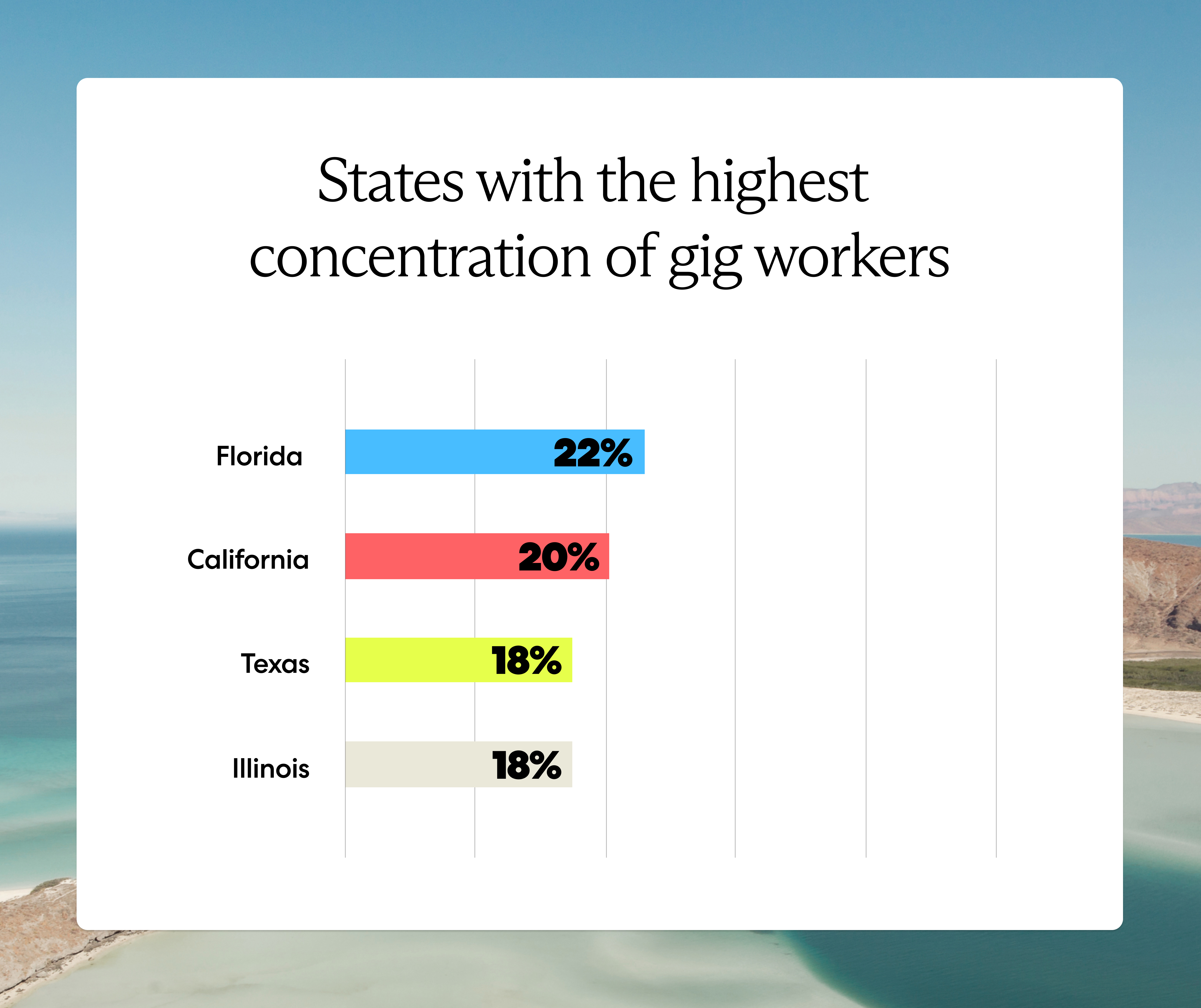
16% of Americans have completed a job via an online gig platform.
Source: Pew Research Center
Data shows that the global gig economy now accounts for up to 12% of the labor market.
Source: World Bank
More than one-third of the U.S. workforce is now engaged in some form of gig work, projected to rise to half by 2025.
Source: Work Life
At 40% of organizations, one in four workers on payroll is a gig worker.
Source: ADP
Florida has the highest concentration of gig workers, with 22% of workers in the state doing gig work—this is followed by California (20%), Texas (18%), and Illinois (18%).
Source: ADP
Global gig economy statistics
Though the U.S. has one of the biggest markets and customer bases for freelance work, gig work is popular across the globe. The global freelance market is expected to continue its rapid growth—at a compound annual rate of 15%.
44% of gig economy gross volume comes from customers in the U.S.
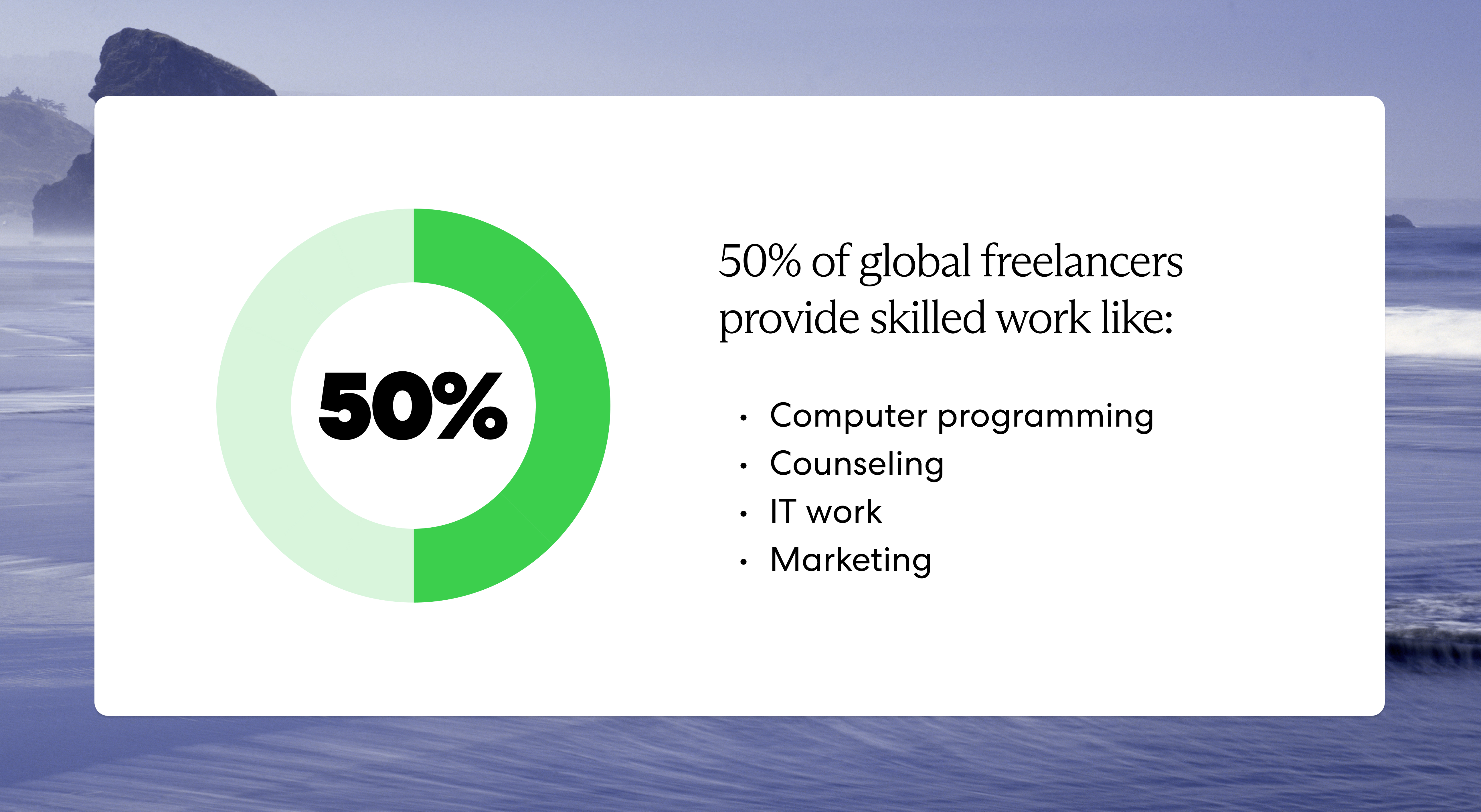
Source: Mastercard
88% of the global gig economy gross volume comes from ride-sharing platforms like Uber and asset-sharing platforms like Airbnb.
Source: Mastercard
The U.S. has the highest global market for gig workers, but India, Indonesia, Australia, and Brazil are rapidly growing, strong markets.
Source: Mastercard
Sales and business development displayed the highest year-over-year growth as a freelance skill, with a 54% increase, followed by data entry at 47%, accounting for 45%, and 3D animation at 44%.
Source: Upwork
Almost 15% of workers in England and Wales complete a gig job at least once per week.
Source: TUC
The global freelance market is expected to grow at a compound annual growth rate (CAGR) of 15% through 2026.
Source: DDIY
The AI sector, particularly generative AI, saw a 600% growth in the number of weekly job posts seeking generative AI skills in 2023.
Source: Upwork
20% of full-time independent workers based in the U.S. have customers outside of the U.S.
Source: MBO Partners
50% of global freelance workers are providing skilled work like computer programming, counseling, IT work, or marketing.
Source: Upwork
Gig economy employee statistics
There is no one-size-fits-all for a gig worker. As there are many different industries and sectors that employ gig workers, there are many different types of people who take on the work. These employees report being happy and fulfilled in their gig jobs.
People with lower incomes are the most likely to do jobs on gig economy platforms.
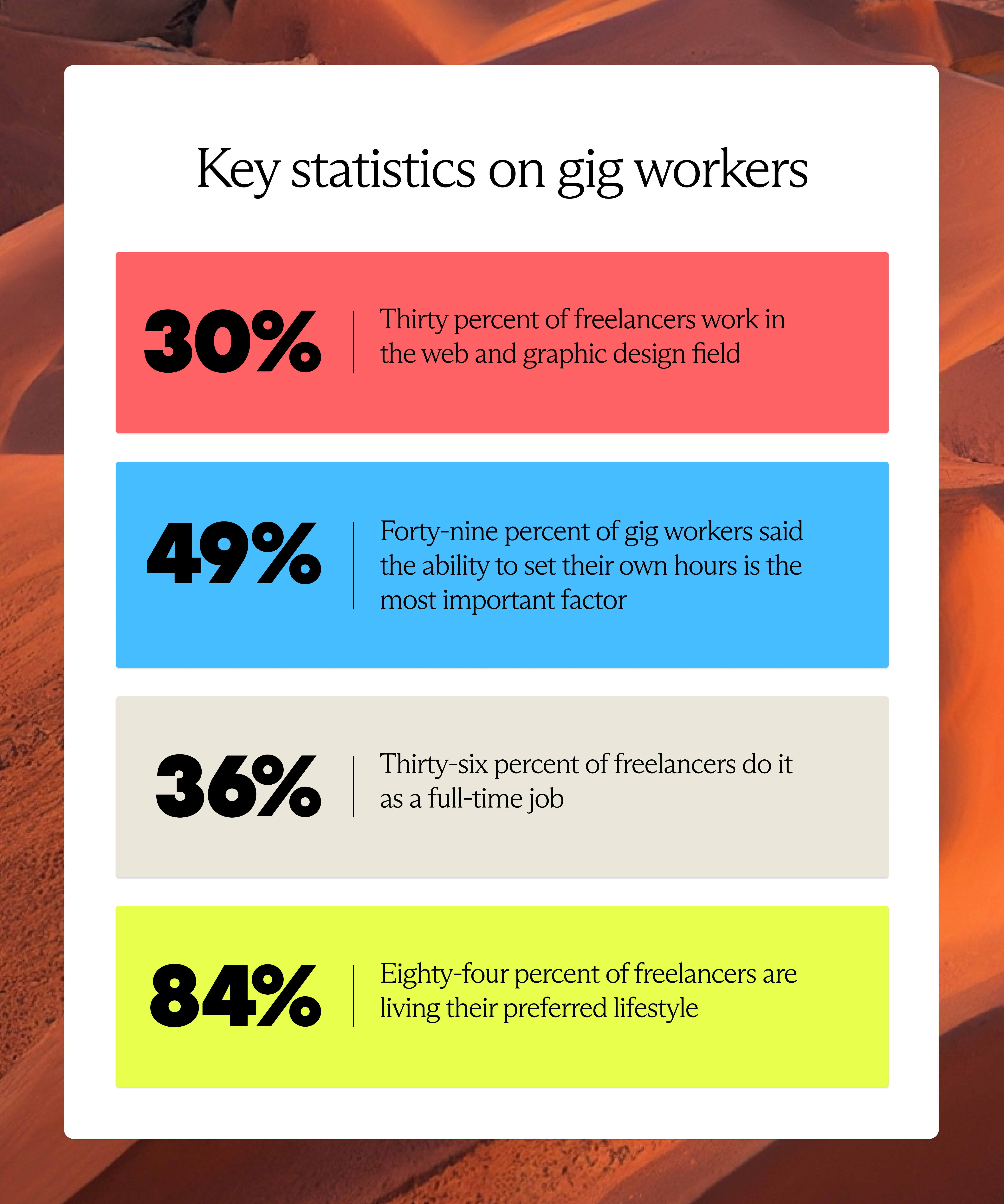
Source: Pew Research Center
49% of gig workers said the ability to set their own hours is the most important factor when working in the gig economy.
Source: Pew Research Center
30% of freelancers work in the web and graphic design field.
Source: Payoneer
Only 40% of American gig economy workers have access to medical insurance.
Source: Statista
57% of sole proprietors in the U.S. work in five sectors: professional services, repair and personal services, construction, administrative services, and retail.
Source: Intuit
44% of freelancers report that they are also caregivers, and 33% report having a disability present in their household.
Source: Upwork
36% of freelancers do it as a full-time job.
Source: Upwork
20% of gig workers are over the age of 55.
Source: ADP
Only 33% of full-time independent workers said they worry about securing future jobs.
Source: MBO Partners
32% of freelancers started freelancing while or just after completing their education, and 22% started freelancing after being laid off from a job.
Source: Upwork
84% of freelancers are living their preferred lifestyle, as opposed to 54% of traditional employees.
Source: Upwork
Gig economy earnings & rates
How much professionals earn in the gig economy varies widely based on factors like age, experience, and skill set. Let's take a closer look at some money-making figures that shed light on the current financial landscape of gig work.
About a quarter of Americans (24%) ages 18 and up earn income by working in the gig economy.
Source: Edison Research
70% of freelancers are under 35, 21% are under 25, and 1% are 65 or older.
Source: TeamStage
$21 per hour is the average hourly rate that freelancers charge globally.
Source: Payoneer
Age and experience matter. Gig professionals 55–64 in age earn $36 per hour on average (more than their younger counterparts).
Source: TeamStage
Web & graphic design is the most popular skill set among freelancers, followed by content writing, programming, and translation.
Source: Payoneer
More than half of professionals in the gig economy say they work harder for their earnings than they would in traditional job roles.
Source: Edison Research
Gig economy financial statistics
While some may assume that gig workers don’t earn as much as those employed on a full-time basis, there is money to be made in the gig economy. In fact, 1 and 5 independent contractors rake in more than $100,000 per year.
Gig workers in the recreation industry make an average of $7,000 per month—$2,000 more than traditional employees in the industry.
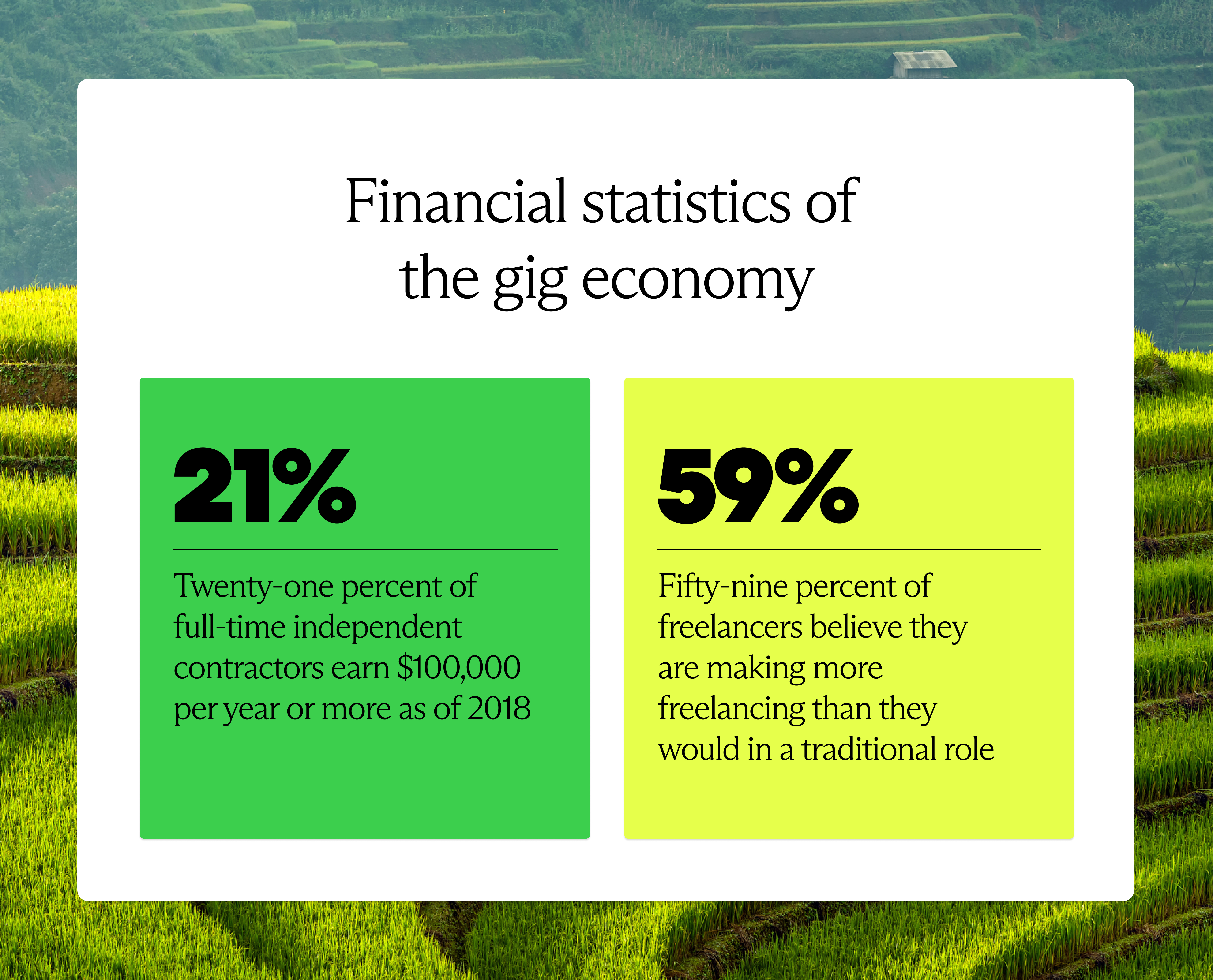
Source: ADP
The average gig worker makes $5,120 per month.
Source: ADP
63% of gig workers said they prefer a flexible work schedule to a bigger salary.
Source: MBO Partners
The average gig worker in the United States makes $69,000 per year—higher than the median U.S. income of $59,000.
Source: MBO Partners
75% of new freelancers said they are taking on freelance work to ensure financial stability during a recession.
Source: Upwork
20% of full-time independent contractors earn $100,000 per year or more as of 2023.
Source: MBO Partners
59% of freelancers believe they are making more freelancing than they would in a traditional role.
Source: Upwork
The future of the gig economy
The future of the gig economy looks bright. Workers think so, too. 86% of freelancers said they think the best days for their industry are yet to come, signaling that many are confident the gig economy will continue to boom.
The gig economy is expected to be valued at $556 billion by 2024.
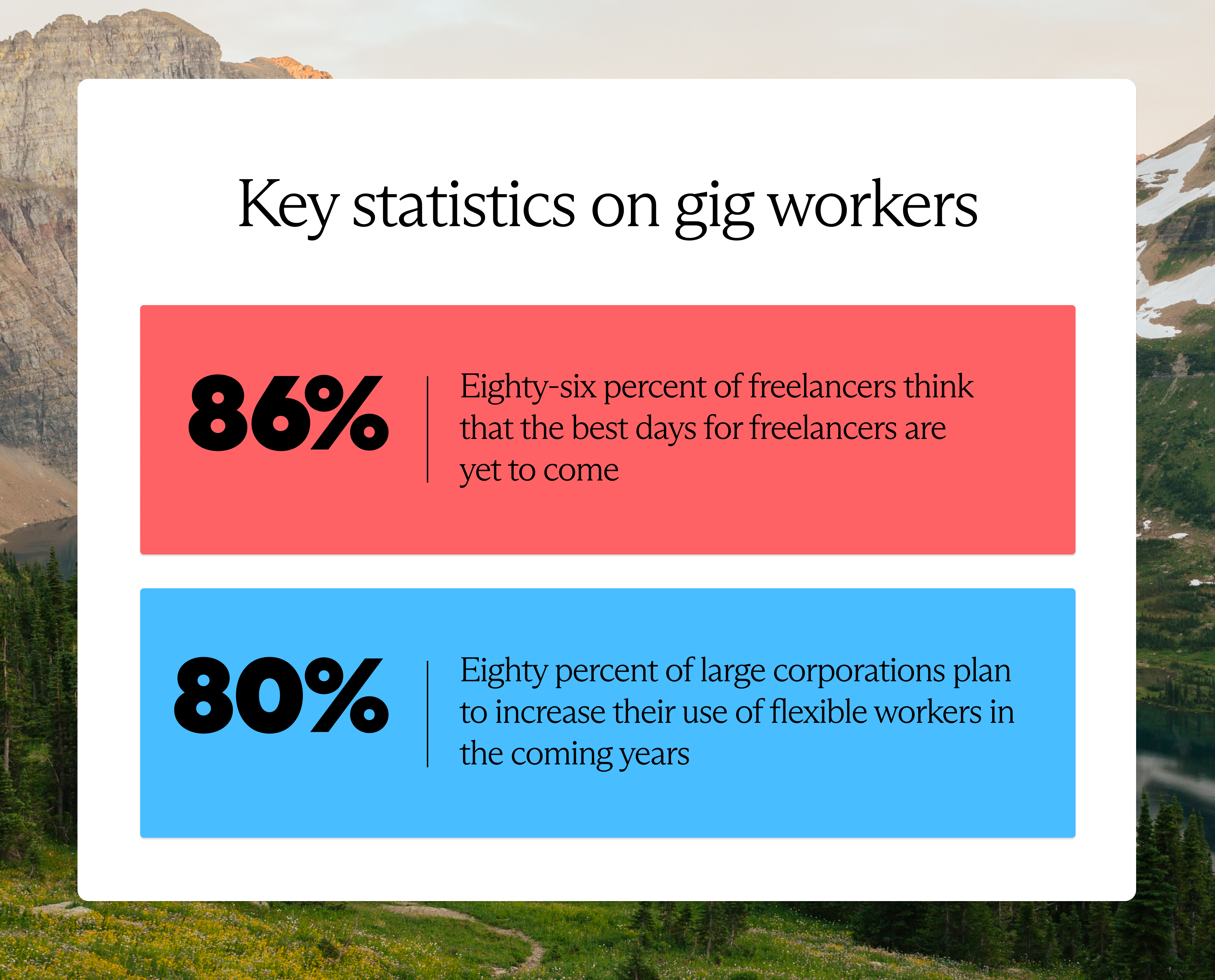
Source: Business Research Insights
86% of freelancers think that the best days for freelancers are yet to come.
Source: Upwork
By the end of 2023, it’s projected that 52% of workers will have spent some of their careers as independent workers.
Source: MBO Partners
55% of full-time independent workers said automation will not impact their job stability.
Source: MBO Partners
48% of new freelancers said they view freelancing as a long-term career choice.
Source: Upwork
80% of large corporations plan to increase their use of flexible workers in the coming years.
Source: Intuit
Gig economy statistics analysis
The gig economy is large and vast. The answer to the question “What is a gig job?” looks different for everyone. For some, gig work means turning their car into a taxi service. For others, it means taking on freelance software engineering work. No matter the industry, though, one thing is certain: The gig economy is growing.
By the end of next year, the number of global gig workers is expected to grow by almost 30 million people (that’s just about the entire population of Venezuela). And currently, one in four employees at 40% of global organizations is employed on a contract basis.
There is also money to be made in gigs. 21% of independent contractors earn more than $100,000 per year. That must be why gig workers range in age from those in college to people reaching retirement age — many of those working in the gig economy are doing so by choice, not because they can’t land a traditional job.
As the job market is ever-evolving into a focus on new work models like asynchronous work, remote work, and a four-day work week, we expect to see the gig economy continue to flourish as an option for those who don’t want to sign an offer letter.
Benefits & challenges of the gig economy
The gig economy is reshaping the world’s work dynamics, offering both opportunities and hurdles for businesses and professionals alike.
Flexibility and scalability
One of the most highly sought-after advantages is its flexibility. Businesses can scale their workforce up or down quickly based on demand. Teams can access specialized skills for specific projects without the long-term commitments of traditional employment.
However, this flexibility comes with its own set of challenges. Ensuring consistent quality across different freelancers or contractors can be complex, and there may be less loyalty or long-term commitment from gig workers.
Cost efficiency vs. investment in talent
Gig work can reduce overhead costs for businesses. A company can minimize expenses associated with full-time employees, such as benefits, office space, and equipment.
On the flip side, this cost-saving approach may lead to a need for more investment in talent development. Without the stability of traditional employment, gig workers may miss out on training opportunities and career growth within the organization.
Access to global talent vs. management complexity
The gig economy opens doors to a global talent pool, allowing businesses to find the best person for the job regardless of location. This can lead to increased innovation and efficiency as the company taps into a wider range of expertise.
Conversely, managing a distributed, global workforce comes with its own set of challenges. Time zone differences, cultural nuances, and communication barriers can complicate project management and team cohesion.
Legal and regulatory considerations
As teams begin to engage with freelancers, it's crucial to chart the legal landscape carefully. Classifying workers as independent contractors versus employees is a contentious issue in many jurisdictions, with potential financial and legal consequences for misclassification.
Tips for thriving in the gig economy
For businesses leveraging gig workers and professionals considering freelancing, here are practical tips to thrive in the gig economy:
- Embrace flexibility, but maintain structure. Setting regular working hours and adhering to them as much as possible can boost productivity and mental well-being.
- Diversify skills or talent pools. For businesses, this means building a diverse network of freelancers. For freelancers, it's about developing a range of marketable skills to stay competitive.
- Prioritize clear communication. In a remote work environment, overcommunication is better than under-communication. Be proactive in reaching out, setting expectations, and providing feedback.
- Grow a digital presence. An online profile is often the first impression in the gig world. Professionals and businesses should keep portfolios, LinkedIn profiles, or company websites up-to-date and reflective of their best work.
- Build a strong network. Networking isn't just for traditional careers. Both businesses and freelancers should cultivate relationships with industry professionals, clients, and other freelancers. These connections can forge new opportunities and collaborations.
- Stay on top of industry trends. The gig economy is constantly evolving. Staying informed about new platforms, tools, and market demands to stay ahead of the curve.
- Manage finances wisely. For gig workers, this means budgeting for inconsistent income and setting aside money for taxes. For businesses, it's about balancing the cost-effectiveness of gig work with investment in core team members.
- Prioritize work-life balance. It's easy to blur the lines between work and personal life in the gig economy. Setting boundaries and making time for self-care helps avoid burnout.
- Embrace continuous learning. Whether it's upskilling or providing learning opportunities for gig workers, continuous education is key to long-term success in this dynamic environment.
- Don't underestimate the power of soft skills. While technical skills are important, soft skills like adaptability, time management, and interpersonal communication are crucial in the gig economy.
Thriving in the gig economy is about leveraging its unique opportunities to create a fulfilling and sustainable career or business model. Flexibility, focus, and a willingness to carve out new paths are essential in this evolving world of work.
Gig economy FAQs
Below are answers to common questions about the gig economy.
Why is it called the gig economy?
The term "gig economy" stems from the nature of work within this system, where individuals typically engage in short-term, temporary positions, colloquially referred to as "gigs."
The phrase "It's a good gig" relates closely to the origin of this term. In this context, each piece of work is considered an individual gig or job. The gig economy has also been called the sharing economy, collaborative economy, or platform economy because of its use of apps like Uber or Airbnb.
Is the gig economy growing?
The gig economy is growing. As more customers and companies hire freelance or contractors, more workers are able to find lucrative gig work. The global gig economy is expected to be valued at $455 billion by the end of next year. And the freelance market alone is expected to grow at a CAGR of 15% year over year through 2026.
What are the pros and cons of the gig economy?
Pros:
- Workers can set their own hours and work when it’s convenient
- Companies gain access to the global pool of talented gig workers looking for work
- Many jobs are short-term and don’t come with a long commitment
- Many gig workers are able to work remotely or from anywhere, providing a better work-life balance
Cons:
- Workers may not receive a steady stream of business, which could cause financial stress if gig work is their primary source of income
- Gig workers may not have access to benefits that traditional jobs provide, like insurance or paid time off
- Taxes can be a headache for gig workers
The gig economy provides many benefits, but the unpredictability of the market may make it inaccessible for some workers. Let’s look at some prominent gig economy pros and cons.
How big is the U.K. gig Economy?
The gig economy in the U.K. is huge—and it’s only getting bigger. As of 2021, almost 15% of workers in England and Wales completed a gig job at least once per week, according to TUC. In addition, 23% of workers in those countries have completed a gig job at some point. From 2016 to 2021, the number of workers who performed remote online digital tasks in the U.K. more than doubled — going from 4.9% to 11.9%.
The future is gig
The gig economy can be lucrative for employees who want short-term work rather than a long-term commitment to a specific company. In turn, hiring gig workers allows companies to diversify their roster and hire innovative talent from anywhere in the world without setting up foreign entities.
But with so many variables and the legal risks of contractor misclassification, the relationship between companies and gig workers can easily become a headache. That's where a compliance partner like Velocity Global can step in to help.
Velocity Global’s integrated Contractor Conversion solution helps global companies quickly and compliantly convert their contingent workforce to full-time employees in more than 185 countries without establishing entities. Retain top talent and mitigate misclassification risks with a global compliance partner like Velocity Global by your side.
Contact us today to see how Velocity Global helps companies stay compliant when building distributed teams.
Topic:
Contractors



